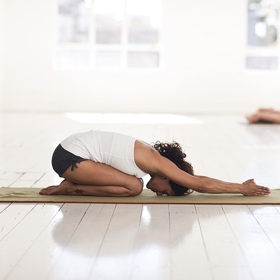Ask your Osteopath: Top tips for a healthy back
Andrew Doody, Resident Shine Osteopath, was asked to answer patients’ most common questions about working from home and the perils of bad posture.
His article featured in “Pick me up” magazine called,
“Ask your Osteopath about working from home”
Find amazing stretches and desk set up advice in his insightful answers below. Plus if you have any further questions:
A friend mentioned yoga is a good way to relieve aches and pains when it comes to back pain. Is that true?
 Yoga can indeed, under the guidance of a professional, be a great way to stretch the back and relieve some forms of back pain, while also promoting relaxation in general. However for long term back pain relief and prevention I would suggest Pilates. Where as yoga largely focuses on mobilisation, Pilates edges more towards stabilisation which better prepares the back for the trials of everyday life.
Yoga can indeed, under the guidance of a professional, be a great way to stretch the back and relieve some forms of back pain, while also promoting relaxation in general. However for long term back pain relief and prevention I would suggest Pilates. Where as yoga largely focuses on mobilisation, Pilates edges more towards stabilisation which better prepares the back for the trials of everyday life.
Quite often when our muscles ache, especially after being in a bad postural position for a while (say on a laptop), it is because the muscles have had to work a lot harder to hold the position. Imagine how much harder it would be for the muscles on the back of the neck to hold the head forward at an angle, rather than just keep it balanced on top of the spine. Bigger stronger muscles have to get involved which are really not designed to work for hours on end and so build up lactic acid and tire quicker, causing aching. Pilates is a learning process (using gentle exercises) which reminds the brain which muscles to use by isolating them, and helps strengthen them. It also trains the body to naturally adapt a better posture which stands you in great stead going forward.
I’ve got neck pain from hunching over my laptop while working from home, what can I do?
Really we have to split this into two sections, pain relief, and prevention going forward.
To help stretch and relax the muscles at the back of the neck after laptop use, the chin-tuck is a good exercise:
Sit up tall in a chair and keep your chin parallel to the floor. Without tilting your head in any direction, gently draw your head and chin back, like you’re making a double chin. Be careful not to jam your head back. You should feel a stretch along the back of the neck.
Now imagine there’s a string pulling your head upward like a puppet, and actively elongate your neck. Actively push the base of your skull away from the base of your neck. Keep your jaw relaxed and hold this position for 3 deep breaths.
Release your chin forward. Repeat.
To help stretch the opposing muscles at the front of the neck caused by the chin down position of using a mobile phone (so called text neck) the exaggerated nod is a good exercise. However be very careful with this as it compresses the joints at the back of the neck, if they hurt already, or while doing the exercise stop.
1. Start by sitting at your desk or standing comfortably with your shoulders relaxed. With your mouth closed — teeth touching but not clenching — look up to the ceiling.
2. Pause here and let your jaw relax and open your mouth. Now see if you can bring your head further back an inch or two (typically you can).
3. Keep your head still here and bring your lower jaw to your upper jaw, closing your mouth. You should feel a stretch in the front of your neck.
Which brings us to prevention and our next question:
Since working from home my back has been in agony. How can I ensure I’m sitting at my desk correctly?
 If possible, designate a specific area in your home for working and always work at a table, sitting on a chair, rather than on the sofa or even worse on your bed.
If possible, designate a specific area in your home for working and always work at a table, sitting on a chair, rather than on the sofa or even worse on your bed.
If your chair isn’t particularly ergonomic, try placing a small cushion, or rolled up towel in the small of your back as a lumbar support.
Adjust the chair height so that your feet are flat on the floor. If the chair isn’t adjustable and feels too high, place something under your feet so that your knees are at right angles, a couple of big books perhaps. If it’s too low, a sturdy cushion to sit on should work.
The top of your screen should be level with your eyebrows, at least 50cm from your face, and, especially if you are working from a laptop, make sure you are not hunching over the screen. Think about buying a computer stand, or raid that bookshelf again and place another couple of books under your laptop so that you can adjust the level of the screen to fit your eye line.
If your laptop screen is at the correct level, the keyboard and trackpad certainly won’t be, so if possible use a detachable keyboard and mouse as this will ensure that your movement is not restricted and you are not placing unnecessary strain on your back, shoulder girdle, or wrists. A good mouse pad with wrist support helps prevent RSI as does a gel wrist support in front of your keyboard.
Taking regular breaks is extremely important, and move around every 20-30 minutes. An easy way to make sure that you get away from your desk is to set an alarm in another room.
When making phone calls, take the opportunity to get up from your desk and move around as you talk, preferably using an earpiece.
Embrace the privacy of working from home by doing regular stretches.
Most importantly if you are feeling any discomfort, either while working or afterwards, don’t ignore it!
You can visit my Youtube Channel for suggested stretches.
My husband suffers from terrible back pain but refuses to do anything about it and instead spends days in bed recovering. Is this the wrong thing to do?
When someone’s back ‘goes’ it can be incredibly painful and often all you feel you can do is find a comfortable position and stay still. Every condition is different and specific and I would want to know the underlying cause before I told someone to ‘get out of bed’, certainly pushing through pain is rarely advisable in these circumstances.
However, that said, your husband’s approach of ignoring the problem and just waiting for it to happen is, as I suspect you have told him many times, absolutely not the thing to do!
A good diagnosis, combined with treatment and preventative action and advice stands an excellent chance of stopping the bed rest episodes from occurring, as well as making sure that whatever the underlying cause may be, it is not either dangerous to ignore, or going to get worse.
